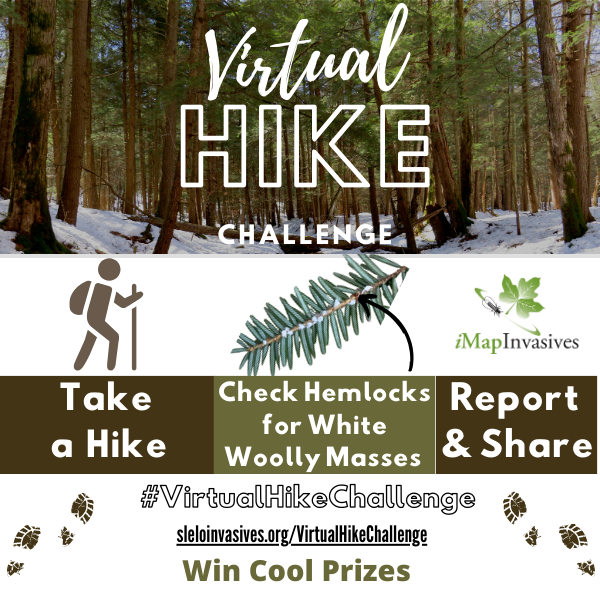Late fall and winter are ideal times of the year to take a hike and check hemlock trees for the presence of an invasive forest pest that kills hemlock trees called hemlock woolly adelgid (HWA). This is because HWA forms a white woolly mass around its body during this time which makes it more noticeable.
November through March you can help protect forests and win prizes by participating in the annual #VirtualHikeChallenge. Participating is simple, fill out the form below, take a hike, check hemlock trees for the white woolly masses of hemlock woolly adelgid, report observations, and share your experience on any social media channel.
#VirtualHikeChallenge Rules
- Fill out the form below so we know you plan to participate & to be entered to win prizes.
- Take a hike (see suggested hiking trails map below).
- Check hemlock trees you encounter for the white woolly masses of hemlock woolly adelgid.
- Report if you do or if you don’t find HWA (see reporting methods below)
- Help raise awareness by sharing a photo of your hiking experience on social media- add the following tags, #VirtualHikeChallenge and @sleloprisminvasives.
Sign up to Take The #VirtualHikeChallenge!
Join upcoming in-person guided hikes to receive hands-on training to learn to survey for hemlock woolly adelgid.
Hikes are held from 10 AM- 12 PM on the following dates. Registration is required.
- October 30th- Inman Glide/Gulf Trail, Rodman, NY
- November 15th- Great Bear Rec. Trail, Fulton, NY
- December 5th- Salmon River Falls, Richland, NY
- January 17th- Trenton Greenbelt Trail, Holland Patent, NY
- February 14th- Forest Park, Camden, NY
Report Observations
Reporting if you did or did not find HWA is important. Learning where HWA is or isn’t found helps strategize management & survey efforts.
Below are two reporting options:
- Report positive and negative observations with a smartphone or mobile device using the iMapInvasives.org mobile app. See below for details.
- If you don’t have access to iMap, you can also report positive observations to the Department of Environmental Conservation’s Forest Pest Hotline at 1-866-640-0652.

NYiMapInvasives is an online, collaborative, GIS-based database and mapping tool that serves as the official invasive species database for New York State.
Click the links below to become familiar with iMap

Any trail in the SLELO region can be visited as part of the challenge.
You can visit any trail in the St. Lawrence Eastern Lake Ontario (SLELO) Region for the challenge. However, below is a map showcasing some public trails in the SLELO region that have hemlocks growing along the path. Click on the icon to learn more about the trails.
Hemlock stands located on trails indicated by blue icons are directly benefiting the Black River Watershed.
How to Search for Hemlock Woolly Adelgid
When you approach a hemlock tree, check the underside of low-lying branches for white woolly masses. The presence of white masses may vary to a single or many masses on a branch. Check several branches from each side of the tree. Pro Tip: Bring a hiking pole to pull down high branches, also check branches you find on the ground.
HWA Look-alikes
You may find spider eggs, pine sap, bird droppings or other things that you may think is HWA, but the white masses you are to look for are only found along the branch at the base of the needles.

Why Care About Hemlocks?
Hemlock trees are important tree species. They are considered a foundation species-meaning that they create the habitat in which they exist. They provide food and habitat for hundreds of forest species; they provide many eco-services such as cooling and filtering water; hemlocks also help reduce soil erosion as they grow along steep slopes and streams.
Hemlock Woolly Adelgid Video Playlist
Watch videos that highlight the importance of hemlock trees, the impacts of hemlock woolly adelgid, and what to look for when surveying for HWA.
Hemlock Woolly Adelgid Playlist
The VirtualHikeChallenge is Supported by:
Supporters share social media posts for the challenge, some also provide prizes and showcase trail systems they manage as part of the challenge.















